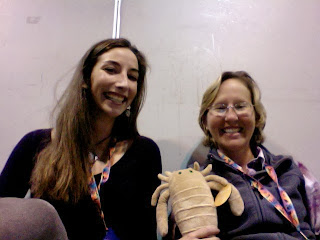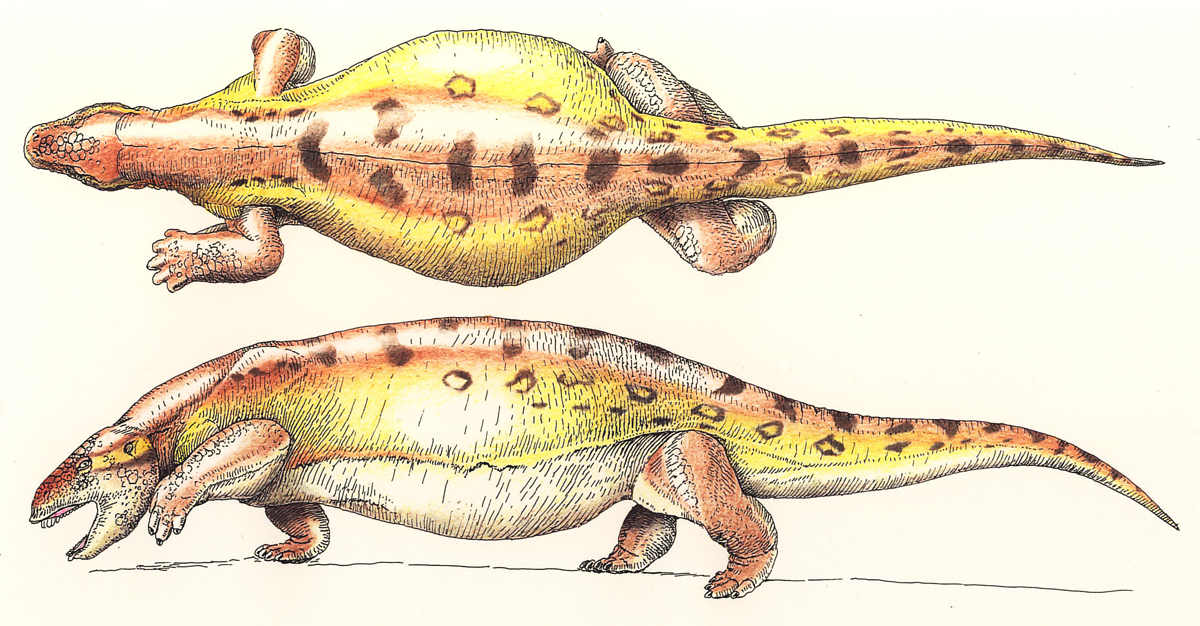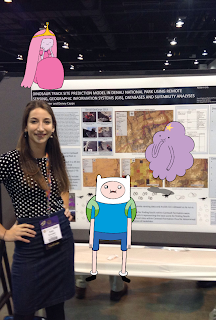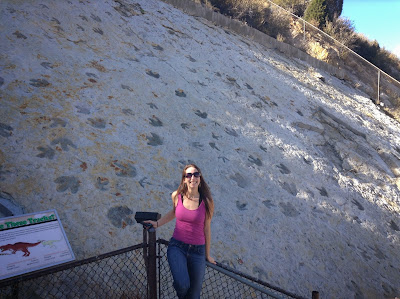 |
| Amy, Kate, and their Paleozoic pal eurypterid! |
I hadn't realized how much I had in common with Kate, who has been my mentor through the Huffington Post Girls in STEM program from afar for a few months. We have plans to rock climb in New Mexico whenever my skin becomes so pale that the SW sun is the only cure to my vitD deficiency.
Favorite talk: BARON CUVIER IN NORTH TEXAS: EARLIEST CLASSIC EXTINCTION OF LARGE LAND HERBIVORES, IN THE EARLY PERMIAN CLEAR FORK GROUP by Robert Bakker
Summary: Back in the day Cuvier defined mass extinction events based on the Pleistocene Megafaunal extinction: the largest land herbivores died out and the top predators took a big hit, too. He also noted that the largest freshwater dwellers like turtles and crocs, as well as small terrestrial species, suffered very little in comparison. Now zoom to Texas: The Arroyo Formation in Texas is mid Lower Permian in age and has been hypothesized to record a Cuvier style extinction, so says Everett Olson in the mid 1900s. He noted that the two largest land herbivores, diadectids and edaphosaurids, were common before the extinction and completely absent from the strata dated after the event.
| What luscious locks! |
Bakker and his team set out to investigate the signal in the Arroyo Fm in order to determine if Olson got it right. Bakker says, yes, yes he did. Bakker began with a hilarious intro, "Good GSA meeting but I wish there were more hats" he said with a huge cowboy hay comfortably resting on his noggin. He referred to diplocaulus as "boomerang heads" throughout the talk and repeatedly complimented Baron Cuvier's fantastic head of hair (see picture to the right). Bakker also called the diadectids the "pin-head" vertebrates in the Permian of Texas, and claimed these early vertebrates were starting the trend for the state's politicians.
 |
| Above: Bush Sr.; Below: Bush Jr. |
Worst Talks:
Unfortunately every year there are a handful of talks that literally make everyone squirm or worse, fall asleep. Here's what folks do wrong during these painful 12-minute torture sessions:
- Reading your talk word for word: Giving a presentation in front of people can be a total bitch, but just because you're nervous doesn't mean you should bore your audience to death to avoid questions. When you write out every part of your talk and then stand up and read that, it lacks the conversational tones of a good talk. When people read instead of explain the talk ends up monotone and better than melatonin.
- Tiny font on your slides: Please save your audience a trip to the eye doctors and practice your talk in a large room! Can you read what's in those TINY EFFING BOXES when you're a few yards away? No? Redo it!!
- Too much font on a slide: if we wanted to read your paper, we'd just read your damn paper. We came to hear what you have to say. It takes away from your work if you just throw blocks on text up on the screen and expect people to read it, or worse, read it to your audience! It's distracting and causes your audience to give up and stop paying attention.
- Be time sensitive: Nothing is more awkward than being in the audience when a speaker blatantly runs over time and just keeps going. You should have practiced your talk enough to know your timing. These sessions are packed with talks back to back, if you run over then it screws up the order the rest of the day. Be considerate and don't be so afraid of questions that you talk over your time, it looks juvenile.
POSTER SESSIONS!!!
 |
| I got a lot of interest about my GIS work in Denali. |
 |
| Did I mention the beer was free? |
Poster Pros:
- Big beautiful eye-catching images! Whether it's a graph, a map, or a photo, good posters have easy to see and read images that make you look twice as you walk past.
- Font big enough to read from across the aisle. At first I was self-conscious about the large font on my poster, but soon I received multiple compliments on its readability (Note: This is not a phenomenon that should be WORTHY OF COMPLIMENTING - be better, everyone). Other students made remarks such as "oh yeah I like that you don't have to stand all up close and awkward-like to read your poster while you're standing right there!" No worries friend, creep from afar! Amy's gotcha.
- Right size. A good poster is not too big and not too small. The poster size guidelines are listed on the GSA website and if you didn't double check, it showed.
Poster Cons:
- Using one, big image as your background. We know this sounds so cool in theory, and yes, I have made this mistake before with posters. The downside is that you never really know how it's all going to look printed. The photo could be pixilated, or your font color can blend right in with the background. It makes reading more difficult and the whole process takes up more time and ink than necessary.
- Overwhelming graphs and figures. This could be seen a few ways: blocks of graphs/figures should be avoided just like the walls of text. Also, figures can become overwhelming when there is no proper explanation handy, i.e. no caption. The majority of time posters are up the authors are not present, therefore your poster should be self-explanatory.
------------------------------------------------------------------------------------------------------------
| The Denver Convention Center and its peeping blue bear. |
I'll have to admit that my favorite day of the conference was Sunday, when I wasn't at the convention center at all. Instead I joined my paleo-savvy relatives on a trip to the Dinosaur Ridge tracks in Morrison, CO. This incredible track site not only records behavioral information about dinosaurs in the hundreds of tracks preserved there, but also is home to the Dakota Ridge hogback, a section of rock that spans the K-T boundary. On the other side of the hogback is the Dinosaur Ridge Bone Quarry, discovered in 1877 by Arthur Lakes. Between holding hands with dinosaurs, walking through millions of years of geologic time, AND enjoying some much appreciated sunshine, it was a great day for a paleontologist.
 |
| CAN YOU SAY GEOGASM?? |



No comments:
Post a Comment